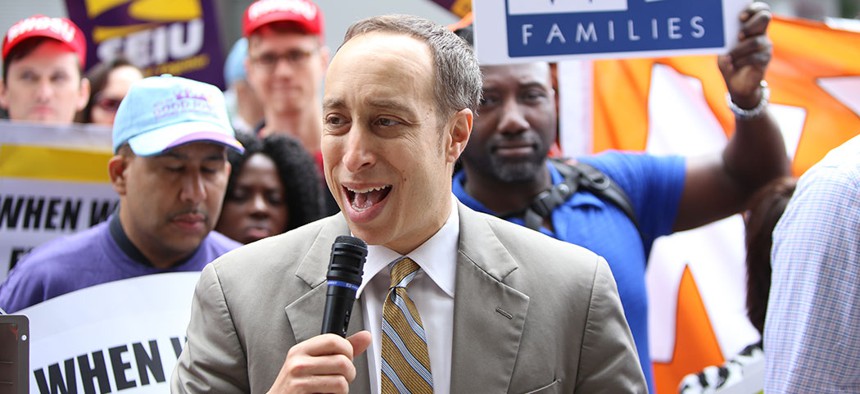The Working Families Party is no stranger to headlines – lately, it’s been making news for its support of fusion voting, which may be on the chopping block, depending on what the state Public Campaign Financing Commission decides to do. Ostensibly, the commission is meant to create, as its name suggests, a public campaign finance system for state elected positions, but it could also tackle fusion voting under the statute that created the commission.
So what is the WFP, and how exactly does the third party work? Here’s a handy guide to help make sense of the minor party and its work in New York.
What makes the WFP a party?
In New York, a party gets official designation if its candidate for governor received at least 50,000 votes. When this happens, the party goes from being simply an organization to an actual party and receives the perks that go with it, including a party committee, which has a much higher contribution limit than normal committees, and a housekeeping committee, which is used for expenses related to running the party and has no contribution limits. Party committees are also able to make unlimited transfers to its candidates.
What does the party stand for?
The Working Families Party has roots with both labor unions and community groups, although its union backers have decreased considerably in recent years. (More on that later.) More than anything, though, the WFP is a progressive third party whose support is seen as a candidate’s left-wing bona fides. Its status as a progressive institution in New York has increased over the years, which is why it got criticized for supporting then-Rep. Joseph Crowley over insurgent candidate Alexandria Ocasio-Cortez in 2018. It faced similar criticism for ultimately giving its ballot line to Gov. Andrew Cuomo in the 2018 general election after initially endorsing Cynthia Nixon. However, the party often takes credit for shifting more moderate candidates to the left.
Why does it want to keep fusion voting?
The WFP generally runs candidates through fusion voting, giving its ballot line to Democrats it supports through a Wilson Pakula, which enables a party to allow a nonparty member to appear its ballot line. This is especially true for gubernatorial races, when the WFP cross-endorses the Democratic candidate, ensuring that its candidate will receive the necessary 50,000 votes for the party to retain its automatic ballot access and remain an official party. The party also prides itself on not being a spoiler thanks to fusion voting – it can run candidates and keep its status while not risking splitting the progressive vote and potentially allowing a conservative candidate to win. This caused issues in the last gubernatorial race. The WFP originally backed Cynthia Nixon, but left the door open to give its ballot line to Gov. Andrew Cuomo should he ultimately make it to general. (Spoiler alert: He did.) Without getting into the weeds of how it did so, the WFP got Nixon off its line so she wouldn’t potentially split the vote and allow Republican Marc Molinaro to win, and gave its line to Cuomo.
The question of whether the WFP could keep its party status without fusion voting remains unclear. The party has only 41,633 active registered members statewide, but the Green Party, which has about 15,000 fewer active members, always runs its own gubernatorial candidate and constantly receives enough votes. However, if fusion voting is eliminated, the WFP may be reluctant to run its own candidates for fear of splitting the liberal vote.
What is the state WFP’s relationship with the national party?
The WFP originated in New York – whose state chapter remains the most prominent and powerful – in 1998. The national party, as well as different state chapters, came later. The New York chapter, led by Bill Lipton, has a state committee that votes on whom it wants to endorse, since that person is usually a nonparty member. The WFP gives its ballot line to that person, a move that theoretically should be set in stone before Democratic primaries, but often includes a workaround to give the line to someone else if necessary. A similar process happens at the national level, when party leadership and party members vote on which candidate to endorse. This year, that person is U.S. Sen. Elizabeth Warren. However, this vote is only an endorsement in the Democratic primary and does not necessarily mean that the party will give Warren its ballot line in the 2020 general election.
What happened between the WFP and the labor unions?
Last year, during the gubernatorial race, several powerful unions that helped found the WFP broke with the party. The split came as a result of the party’s decision to support Nixon, which the unions disagreed with, siding with Cuomo. The groups that left were 32BJ SEIU, the Communications Workers of America and the Retail, Wholesale and Department Store Union. They joined 1199SEIU, United Federation of Teachers, the New York Hotel and Motel Trades Council and the Transport Workers Union, which had already left the party in prior years. Some of the unions even floated the possibility of forming a new party, a prospect that never went anywhere.


